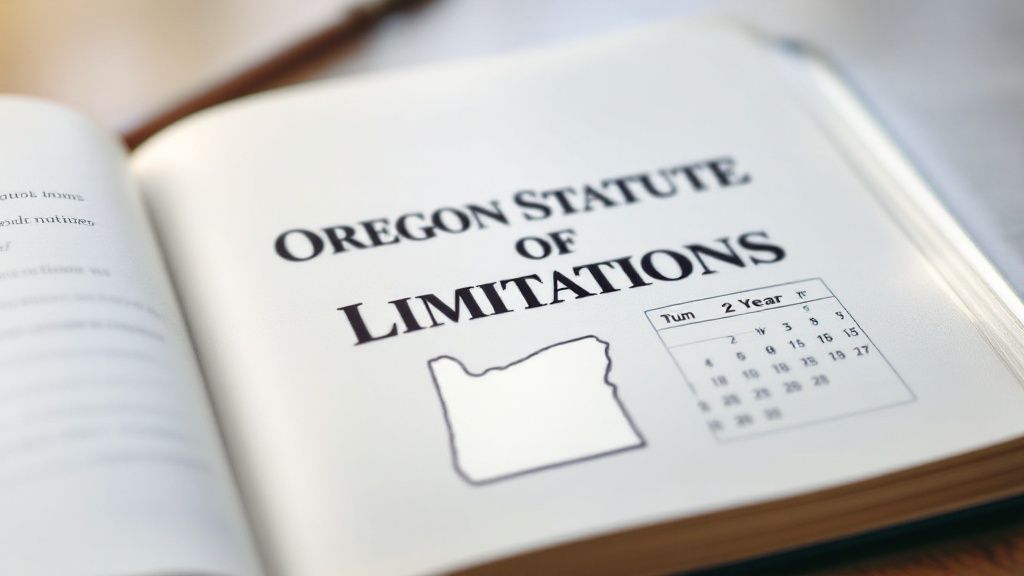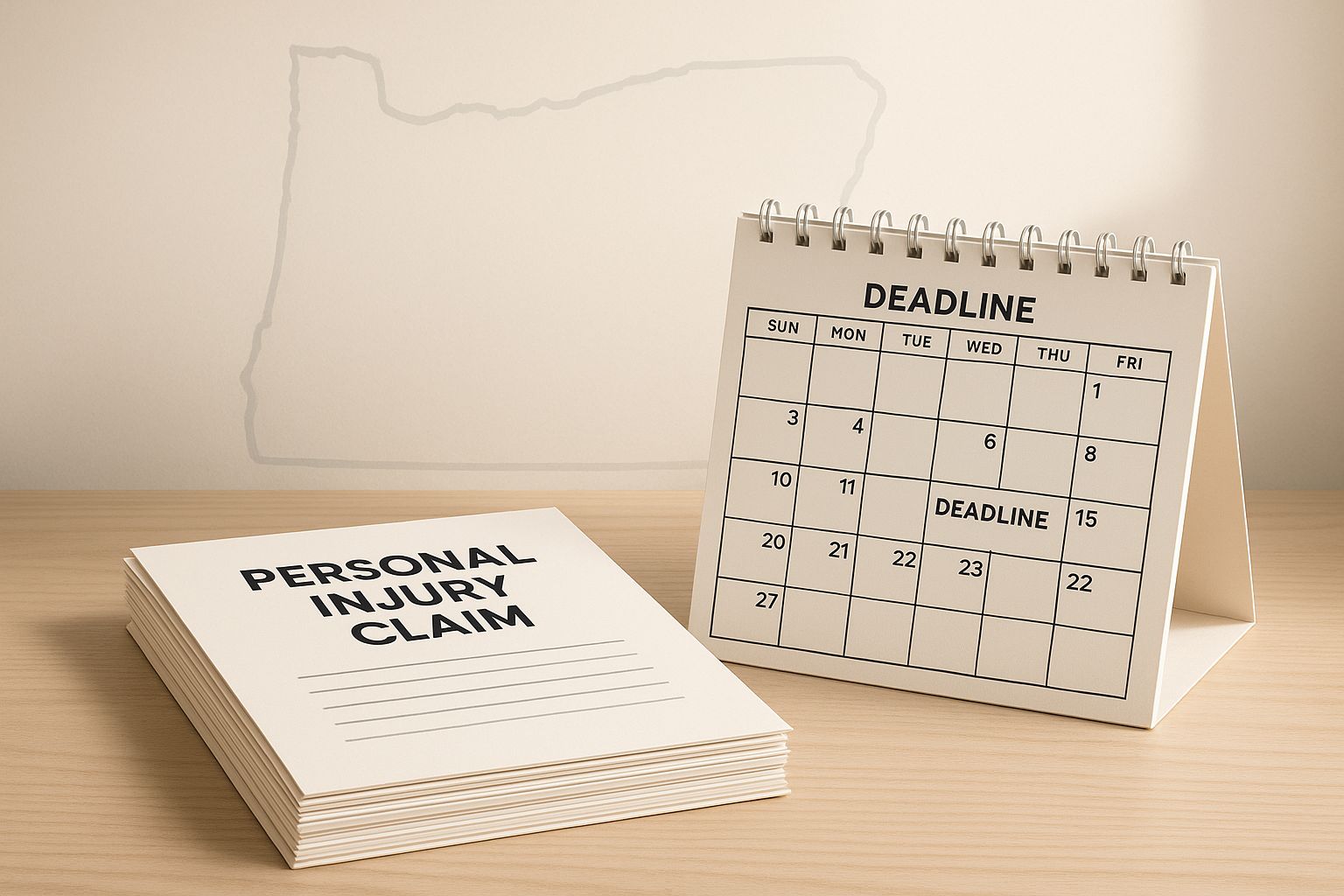Statute of Limitations Oregon Personal Injury: Know Your Rights
"I was satisfied once John Bell took over my case."
"Communication was always timely."
Statute of Limitations Oregon Personal Injury: Know Your Rights
When you've been injured because of someone else's negligence, the last thing you want to think about is a legal deadline. But in Oregon, there's a critical countdown clock on your right to seek justice, and it's called the statute of limitations.
For most personal injury cases in Oregon, that clock is set to two years from the date you were injured. This isn't just a suggestion; it's a hard and fast rule. Miss it, and the door to the courthouse usually slams shut for good, regardless of how strong your case is.
Understanding Oregon's Two-Year Filing Deadline

So, why does this deadline exist? Think of it as a way to ensure fairness for everyone involved. It pushes people to bring their claims forward while evidence is still fresh—witness memories are clearer, physical evidence hasn't disappeared, and documents are easier to locate. This prevents a defendant from having the threat of a lawsuit hanging over their head indefinitely.
The law behind this is found in Oregon Revised Statutes (ORS) 12.110(1), which sets the general two-year window. For a deeper dive into the legal framework, understanding the broader field of personal injury law provides valuable context on why these time limits are so central to the process.
The Consequences of Inaction
Letting that two-year window close without taking action is a devastating mistake. If you try to file your lawsuit even a single day late, the defendant's attorney will immediately ask the court to dismiss your case. And in almost every situation, the judge will have no choice but to agree.
This is a critical point: The strength of your case, the severity of your injuries, or the clear fault of the other party becomes irrelevant once the deadline passes. You permanently forfeit your right to seek financial recovery through the courts.
It’s important to remember that this deadline is for filing the lawsuit, not for settling your claim. Your case doesn't have to be completely wrapped up in two years, but the official legal process must be started before that time runs out.
Deadlines for Common Injury Claims
While the two-year rule covers many situations, it's helpful to see how it applies to specific types of cases. Some claims, like wrongful death, even have a different timeline altogether.
Here is a quick reference guide to the standard filing deadlines you'll encounter for common personal injury claims in Oregon.
Oregon Personal Injury Deadlines at a Glance
| Car Accidents | Two Years from the date of the accident. |
| Slip and Fall Injuries | Two Years from the date the fall occurred. |
| Medical Malpractice | Two Years from the date the malpractice was discovered. |
| Product Liability | Two Years from when the injury occurred or was discovered. |
| Wrongful Death | Three Years from the date of the injury that caused the death. |
This table serves as a starting point. As you can see, knowing the specific nature of your injury is key to determining your exact deadline.
When Does the Filing Clock Actually Start Ticking?

While Oregon’s two-year deadline sounds straightforward, figuring out the exact day the clock starts can be surprisingly complex. Many people assume it’s always the date the accident or injury happened. But the law is smarter than that, especially when an injury doesn't show up right away.
This is where Oregon's "discovery rule" comes into play. It's a critical legal concept that acknowledges a simple truth: you can't file a claim for an injury you don't even know you have.
The discovery rule basically says the two-year countdown doesn't start on the date of the incident. Instead, it begins on the date the injury was discovered or reasonably should have been discovered.
This small but mighty detail is designed to protect your rights, especially in cases where the true damage from an incident takes weeks, months, or even years to surface. It shifts the starting line from the moment of the harmful act to the moment of your awareness.
How the Discovery Rule Works in the Real World
Let's use an example. Say a surgeon accidentally leaves a small piece of medical gauze inside a patient. The patient feels perfectly fine for a year, then starts having strange, persistent abdominal pain. After several doctor visits, an imaging scan finally reveals the forgotten object.
Under the discovery rule, the two-year clock wouldn't start from the date of the surgery. That would be unfair. Instead, it would likely begin on the date of the scan—the day the patient finally discovered the cause of their suffering.
This same principle can apply to many other situations where harm isn't immediate, from chemical exposure to slowly developing back problems after a fall. If you have questions about a car crash specifically, our guide on how long you have to file a claim after an auto accident has more details.
What Does "Reasonably Should Have Known" Mean?
Now for the other side of the coin: the "reasonably should have known" part of the rule. This is just as important. The law expects people to be reasonably proactive about their own health and well-being.
Imagine you were in a fender bender and developed a nagging, constant headache a week later. If you ignored that headache for over a year without ever seeing a doctor, a court might argue that a reasonable person would have sought medical help much sooner. In that case, they could decide your filing clock started ticking long before you finally got a diagnosis.
You can't just ignore obvious symptoms to extend your deadline. When determining this "reasonable" date, a court will look at a few key things:
- Symptom Severity: Were your symptoms significant enough that an ordinary person would have been concerned and seen a doctor?
- Medical Advice: Did a physician diagnose the problem or suggest that your symptoms were connected to the incident?
- Obvious Connection: Was it logical to connect the symptoms you were experiencing back to the original event?
Getting a handle on this distinction is crucial. It directly impacts your filing deadline and is often a key point of argument in a personal injury case.
Exceptions That Can Change Your Filing Deadline
While Oregon's two-year filing deadline is a pretty firm rule, it’s not set in stone. The law understands that life happens, and certain circumstances can make it nearly impossible—or downright unfair—to expect someone to file a lawsuit within that standard window. For these specific situations, the law allows the countdown clock to be paused. This legal concept is known as "tolling."
Think of tolling like hitting the pause button on a stopwatch. The time that has already run is locked in, but the clock stops ticking until the situation resolves. Getting a handle on these exceptions to the standard statute of limitations oregon personal injury timeline is crucial, as they can give you the breathing room you need to protect your legal rights.
This infographic breaks down the key scenarios where Oregon's personal injury deadlines might shift.

As you can see, circumstances like the victim's age or a claim against a government body create unique timelines that are very different from the usual two-year rule.
When the Injured Person Is a Minor
One of the most common and important exceptions applies to personal injury claims for children—anyone under the age of 18. Oregon law recognizes that kids can't file lawsuits for themselves.
Because of this, the statute of limitations is tolled for a minor. The two-year clock doesn't even start running until the day they turn 18 years old. So, a child who was injured at age 10 has until their 20th birthday to file a personal injury lawsuit.
Individuals Lacking Mental Capacity
A similar safeguard is in place for people who are considered legally incapacitated when their injury occurs. This could be due to a severe mental illness or a cognitive disability that stops them from understanding their legal rights or handling their own affairs.
In these situations, the statute of limitations is paused. The clock will only start ticking if and when the person’s legal competency is restored, making sure they aren't punished for a condition beyond their control.
Special Rules for Claims Against the Government
Heads up: suing a government entity in Oregon is a completely different ballgame. Whether you're up against a city, county, or state agency, you face a unique set of rules and much shorter deadlines. This is a critical distinction that trips up a lot of people.
Under the Oregon Tort Claims Act, you must first give the proper government body a formal "tort claim notice."
- You have only 180 days from the date of injury to send this notice.
- For a wrongful death claim, this notice period is extended to one year.
This is a non-negotiable first step. If you miss that 180-day window to provide formal notice, you will almost certainly lose your right to file a lawsuit later, even if you’re still well within the general two-year statute of limitations.
After you've correctly filed the notice, the standard two-year deadline to file the actual lawsuit still applies. This two-part system makes claims against the government incredibly complex and time-sensitive.
How Negligence Rules Affect Your Injury Claim
Filing your claim before the statute of limitations oregon personal injury deadline is a huge first step, but it’s just that—a first step. It gets you in the door, but it doesn't automatically mean you'll get paid. The next, and arguably most important, piece of the puzzle is how Oregon assigns blame in an accident. This directly impacts whether you can get any money and, if so, how much.
Oregon uses a system called modified comparative negligence. The easiest way to think about it is to imagine a pie chart that represents 100% of the blame for what happened. A judge or jury will slice up that pie and assign a percentage of fault to everyone involved. The size of your slice determines everything.
Understanding Oregon's 51% Fault Rule
In Oregon, the magic number to remember is 51%. This one percentage point is the line in the sand that can make or break your entire case.
Here's the breakdown:
- If you are found to be 50% or less at fault: You can still recover money for your injuries. Your total compensation will just be reduced by your percentage of fault.
- If you are found to be 51% or more at fault: You are completely barred from recovering anything. You walk away with nothing.
This rule is designed to be a fairness check. It stops a person who was mostly responsible for their own injuries from suing someone who was only slightly at fault.
Simply put, Oregon law says that if you are more than halfway to blame for the incident that caused your injuries, you can't collect damages. To learn more, see this overview of how Oregon personal injury laws work and what they mean for your claim.
A Real-World Car Accident Example
Let's see how this plays out with a practical example. Say you're in a car crash and your total damages—for medical bills, lost income, and pain and suffering—come out to $100,000. The other driver blew through a stop sign, which was the main cause of the collision. However, you were going a few miles over the speed limit.
A jury looks at all the evidence and decides the other driver was 80% responsible, but they assign 20% of the fault to you for speeding.
Since your 20% share of the blame is well below the 51% cutoff, you can still collect compensation. Your $100,000 award is simply reduced by your 20% of fault.
- Total Damages: $100,000
- Your Percentage of Fault: 20%
- Amount Reduced: $20,000 (which is 20% of $100,000)
- Your Final Payout: $80,000
This is why understanding these negligence rules is just as critical as meeting the statute of limitations. The deadline gets your case started, but the fault rules decide what you can actually recover.
Navigating the Claim Process Inside the Two-Year Window
Knowing you have a two-year deadline is one thing. Using that time effectively is another entirely. Many people mistakenly believe their entire personal injury case has to be wrapped up, signed, sealed, and delivered within those two years. That's not the case.
The statute of limitations oregon personal injury deadline is only for one specific, critical action: filing the official lawsuit with the court.
Think of it like this: the two-year window is the time you have to get to the starting line of a marathon. The race itself—the negotiation, and if necessary, the lawsuit—has its own timeline. The journey from the day you were hurt to the day you receive a check is often much longer.
Your first priority is to use that time to build an undeniable case to present to the at-fault party's insurance company.
The Pre-Lawsuit Phase
Long before a lawsuit is ever filed, the real work begins. Your legal team will be focused on constructing your claim from the ground up and trying to negotiate a fair settlement. This is where most of the heavy lifting happens, all within that initial two-year window.
Here's what that looks like in practice:
- Evidence Collection: We're talking about gathering every scrap of proof—police reports, photos of the scene and your injuries, witness statements, and anything else that helps paint a clear picture of what happened.
- Medical Documentation: This is crucial. We meticulously compile all your medical records, doctor's notes, hospital bills, and even expert opinions to show the true extent of your injuries and what they've cost you.
- Calculating Damages: Your attorney will carefully tally up all your losses, both the obvious economic ones and the harder-to-quantify non-economic damages. Our guide on a bodily injury claim digs deeper into how these calculations work.
- Negotiation: Once we have all our ducks in a row, we send a formal demand letter to the insurance company and start the negotiation process, aiming to settle this without ever setting foot in a courtroom.
The key takeaway here is that a settlement is often the goal. But all this preparation is done with one eye on the calendar, ensuring that if negotiations fail, your right to sue is fully protected.
When to File the Lawsuit
What happens if the insurance company won't budge or makes a lowball offer? That's when your attorney files the formal complaint with the court. This has to be done before the two-year anniversary of your injury passes. Keeping track of these critical dates and all the case details is why most legal pros rely on tools like the best case management software for attorneys.
Once the lawsuit is filed, your case moves into the formal litigation phase. This action preserves your legal rights, but it also starts a new clock.
Don't expect a quick resolution. Insurance companies can drag their feet, and Oregon courts often schedule trials for 10 to 18 months after the initial filing. This means the entire process, from injury to final verdict, can easily stretch out over several years.
Taking the Right Steps to Protect Your Injury Claim
Knowing the rules is one thing, but putting that knowledge into action is what truly matters. After you've been hurt, what you do in those first few hours and days is absolutely critical. These early steps can make or break your ability to file a successful claim before the statute of limitations oregon personal injury deadline closes.
Think of it as building the foundation for your case. If you act quickly and thoughtfully from the very beginning, you give yourself the best possible chance of success.
Your Immediate Post-Injury Checklist
Here’s a straightforward checklist of what to do right after an injury to protect your rights.
Get Medical Help Immediately: This is non-negotiable, both for your health and your case. Seeing a doctor right away creates a clear, official record linking your injuries to the accident. Any delay gives an insurance company an opening to argue that your injuries weren't that serious or were caused by something else.
Document Everything You Can: If you’re physically able, turn your smartphone into your best tool. Take photos and videos of the scene, your injuries, and any damaged property. Just as important, get the names and phone numbers of anyone who saw what happened. Witnesses can be invaluable.
File an Official Report: Make sure the incident is officially on the record. If it’s a car crash, call the police and get a report number. If you slip and fall at a business, report it to the manager or owner immediately and ask for a copy of their written incident report.
A crucial piece of advice: Don't apologize or admit any fault. Even a simple "I'm sorry" can be twisted by an insurance adjuster to mean you were responsible. Stick to the facts.
Following these initial steps is vital. For a more detailed look at the journey ahead, you can learn more about the complete personal injury claim process in our comprehensive guide. The single most important step, however, is to speak with an experienced attorney as soon as possible. They can guide you through these complexities and ensure your right to compensation is fully protected.
Frequently Asked Questions
When you're dealing with an injury, the legal system can feel overwhelming. Let's walk through some of the most common questions we hear about Oregon's personal injury deadlines.
What Happens If I Miss the Deadline by One Day?
Unfortunately, Oregon's courts are incredibly strict on this. If your lawsuit is filed even a single day after the two-year window closes, you can bet the other side's attorney will immediately ask the court to throw it out.
In almost every situation, the judge will have no choice but to grant that request. This means you lose your right to seek compensation forever, no matter how strong or valid your case was.
Does Filing an Insurance Claim Pause the Clock?
No, it absolutely does not. This is a crucial point and a common misunderstanding that can completely derail a valid claim.
Filing a claim with an insurance company is a separate administrative process. The legal clock—that two-year statute of limitations—keeps ticking regardless of any conversations or negotiations you have with an adjuster. You have to file a formal lawsuit in court before that deadline hits to protect your rights, even if you think a settlement is close.
Be cautious: It’s a well-known tactic for insurance companies to drag out negotiations, hoping you’ll run out the clock. Don't let ongoing talks with an adjuster give you a false sense of security.
Can I File a Claim for an Injured Family Member?
Yes, in many cases, you can. It all depends on the specific situation.
If the injured person is a minor (under the age of 18), a parent or legal guardian has the authority to file the lawsuit for them. Likewise, if an adult family member is incapacitated and can't manage their own affairs because of their injuries, a court-appointed guardian or conservator can step in and start the claim on their behalf.
At Bell Law, our experienced attorneys are here to answer all your questions and make sure your claim is handled correctly and on time. Don't risk losing your rights—reach out to us for a free consultation.







